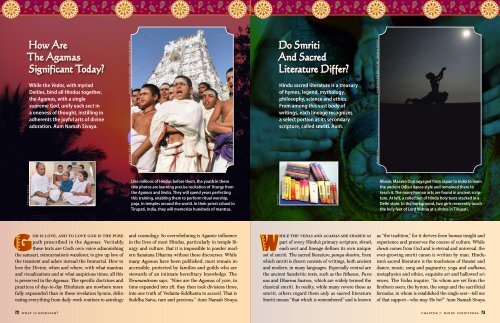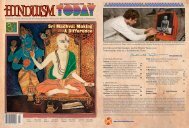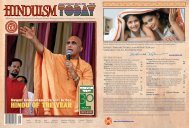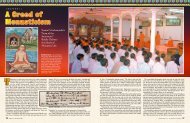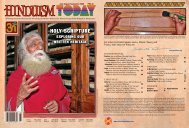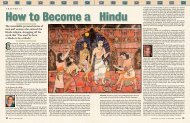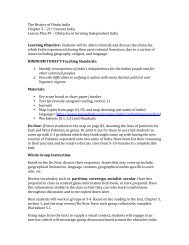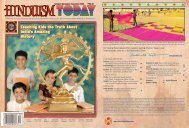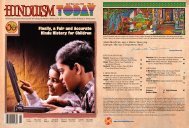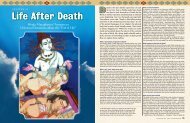You also want an ePaper? Increase the reach of your titles
YUMPU automatically turns print PDFs into web optimized ePapers that Google loves.
How AreThe AgamasSignificant <strong>Today</strong>?While the Vedas, with myriadDeities, bind all <strong>Hindu</strong>s together,the Agamas, with a singlesupreme God, unify each sect ina oneness of thought, instilling inadherents the joyful arts of divineadoration. Aum Namah Sivaya.thomas kelly background photo, hinduism todayDo SmritiAnd SacredLiterature Differ?<strong>Hindu</strong> sacred literature is a treasuryof hymns, legend, mythology,philosophy, science and ethics.From among this vast body ofwritings, each lineage recognizesa select portion as its secondaryscripture, called smriti. Aum.manas das background photo by thomas kellythomas kellyLike millions of <strong>Hindu</strong>s before them, the youth in thesetwo photos are learning precise recitation of liturgy fromthe Agamas and Vedas. They will spend years perfectingthis training, enabling them to perform ritual worship,puja, in temples around the world. In their priest school inTirupati, India, they will memorize hundreds of mantras.dinodiaAbove, Masako Ono voyaged from Japan to India to learnthe ancient Odissi dance style and remained there toteach it. The many human arts are found in ancient scripture.At left, a collection of <strong>Hindu</strong> holy texts stacked in aDelhi store. In the background, two girls reverently touchthe holy feet of Lord Vishnu at a shrine in Tirupati.God is love, and to love god is the purepath prescribed in the Agamas. Veritably,these texts are God’s own voice admonishingthe samsari, reincarnation’s wanderer, to give up love ofthe transient and adore instead the Immortal. How tolove the Divine, when and where, with what mantrasand visualizations and at what auspicious times, all thisis preserved in the Agamas. The specific doctrines andpractices of day-to-day <strong>Hindu</strong>ism are nowhere morefully expounded than in these revelation hymns, delineatingeverything from daily work routines to astrologyand cosmology. So overwhelming is Agamic influencein the lives of most <strong>Hindu</strong>s, particularly in temple liturgyand culture, that it is impossible to ponder modernSanatana Dharma without these discourses. Whilemany Agamas have been published, most remain inaccessible,protected by families and guilds who arestewards of an intimate hereditary knowledge. TheTirumantiram says, “Nine are the Agamas of yore, intime expanded into 28, they then took divisions three,into one truth of Vedanta-Siddhanta to accord. That isSuddha Saiva, rare and precious.” Aum Namah Sivaya.While the vedas and agamas are shared aspart of every <strong>Hindu</strong>’s primary scripture, shruti,each sect and lineage defines its own uniqueset of smriti. The sacred literature, punya shastra, fromwhich smriti is drawn consists of writings, both ancientand modern, in many languages. Especially central arethe ancient Sanskritic texts, such as the Itihasas, Puranasand Dharma Sastras, which are widely termed theclassical smriti. In reality, while many revere these assmriti, others regard them only as sacred literature.Smriti means “that which is remembered” and is knownas “the tradition,” for it derives from human insight andexperience and preserves the course of culture. Whileshruti comes from God and is eternal and universal, theever-growing smriti canon is written by man. <strong>Hindu</strong>ism’ssacred literature is the touchstone of theater anddance, music, song and pageantry, yoga and sadhana,metaphysics and ethics, exquisite art and hallowed sciences.The Vedas inquire, “In whom are set firm thefirstborn seers, the hymns, the songs and the sacrificialformulas, in whom is established the single seer—tell meof that support—who may He be?” Aum Namah Sivaya.72 what is hinduism?chapter 7: hindu scriptures 73


